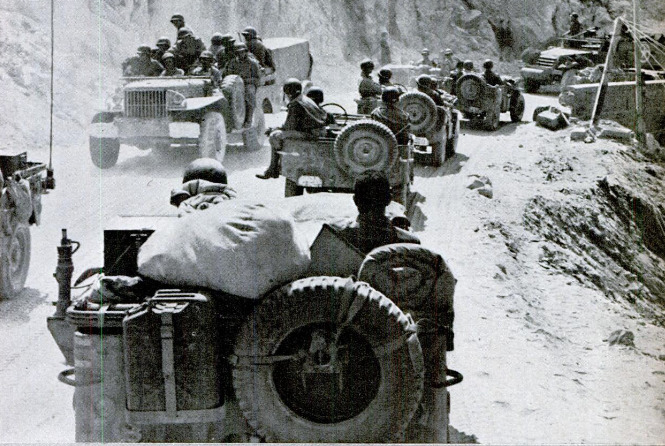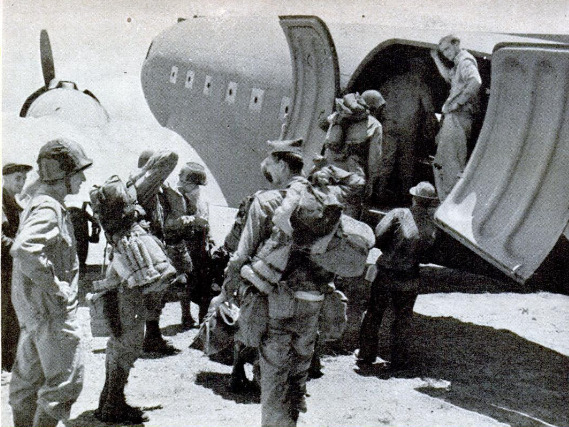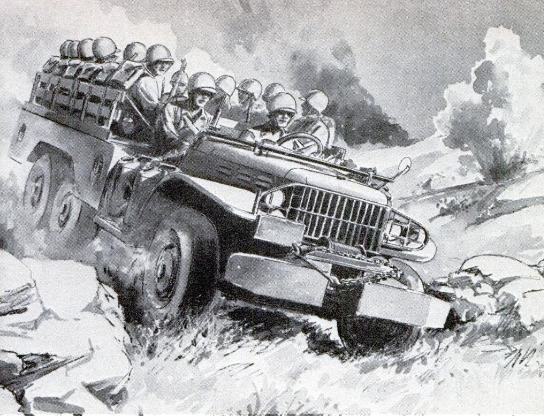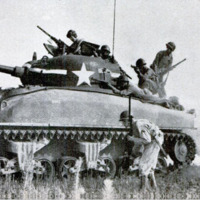-
Title (Dublin Core)
-
U. S. Modern Infantry Vehicles
-
Article Title and/or Image Caption (Dublin Core)
-
Modern Infantry Rides to Battle on Wheels...and Fights on Its Feet
-
extracted text (Extract Text)
-
MOTORIZED infantry, a new weapon
in the American arsenal, has now
met the finai test of major battle,
and many military observers believe that
these high-wheeling foot soldiers will deal
the decisive and finishing blows in the great-
est war of world history.
Fast infantry is a relatively new concept
in war. From the dim days of Cyrus the
Great to the first World War, the fate of bat-
tles and nations was decided, in the main,
by the shock of troops who marched and
maneuvered at the classical pace of three
miles an hour.
‘The gasoline engine has changed all that.
A modern motorized infantry division can
move 10 miles per hour over poor roads, 15
over secondary roads, and 20 or 25 on good
highways. In terms of battle strategy, this
means that troops who used to move to the
battle front at 15 to 25 miles a day can now
approach action at 100 to 150 miles a day.
The whole pace of a military operation de-
velops about six times faster than in the past.
This speed-up has greatly increased the
advantage of the force that can seize and
hold the initiative. It has made this a truly
offensive war, as contrasted with the grind-
ing defensive struggle which the trench and
machine gun made of World War I.
Motorization also has put the element of
deception back into large-scale war by mak-
ing possible the rapid grouping of forces for
an attack at an enemy weak point. In World
War I, the opposing commanders had to de-
pend almost entirely on railroads, and it
took weeks to pile up the overpowering
quantity of supplies and troops needed to
mount an offensive.
Motorized infantry has not cut so spectac-
ular a figure in the war reports as its mech-
anized partner, the armored force, yet its
basic function is fully as important as that
of the tank formations. It nails down and
exploits the gains that the tanks batter out;
to use an analogy with football, the tank
first opens a hole in the enemy line, and
then the motorized division carries the ball.
‘There is a practical reason for this. The
armored division, preceded by infiltrating in-
fantry, is formidable in attack, but has rela-
tively little defensive strength or holding
power. It is never more vulnerable than at
the moment when its forward lunge has been
halted, its headlong momentum spent. That
is when the motorized division becomes es-
pecially valuable. Following the armored
striking force through the gap in the ene-
my’s formations, the fast infantry occupies
roads, crossings, bridges, towns, and other
strategic points. Then it fans out, rolling
back the flanks of the gap or curving back
to attack from the rear.
Moreover, if the initial break-through suc-
ceeds in disrupting the enemy resistance, the
main job of pursuit and destruction falls to
the motorized divisions. For this task they
have the right combination of great mobili-
ty plus great combat strength and fire pow-
er. They can hit hard to break up any re-
organized center of resistance, or, if the ene-
my develops a strong counterattack, they
can dig in and hold until the armored force
and other reinforcements are brought up to
strike again. This process, in which units
of an army take turns in striking and sup-
porting each other, is called “leapfrogging.”
‘The motorized division's function of pur-
suit after a break-through is of great im-
portance. Correspondents and commentators
who have studied the massive fighting in
Russia since 1041 are inclined to believe that
both the Nazis and the Russians missed
chances to win crushing and decisive vic-
tories in the first year by not having enough
motorized divisions to exploit initial success-
es. Both armies inflicted heavy defeats on
the enemy during their separate offensives;
neither side had enough fast infantry to
prevent the other from carrying out an or-
derly retreat.
‘There is nothing essentially mysterious or
startling in the organization of a motorized
infantry outfit. It is simply an infantry di-
vision permanently equipped with its own
motor transportation. The men ride their
vehicles to the zone of action, then dismount
and fight on foot as any other infantrymen
would.
The idea was tried out on a limited scale
during World War I. Wherever possible,
troops going up to the front were hauled by
truck; no soldier who rode very far in a
1916-model camion will ever forget the ex-
perience. But the number of trucks and
lorries that were available always was rela-
tively small. Major movements of troops
and equipment were pretty well confined
to the existing railway nets.
The modern motorized division, however,
rolls along in style, riding in some 3,000
vehicles of all types, ranging from the fast
scouting motorcycle to the heavy cargo
truck. Such a division will include about
12,000 men. It is slightly smaller than a
standard triangular infantry division, but
has greater fire power, mainly because it is
more lavishly equipped with automatic
weapons.
The U. S. motorized division has jeeps,
half-ton trucks, three-quarter-ton heavy-
weapons carriers, and 2 1/2-ton cargo trucks
and personnel carriers as its basic vehicles.
The omnipresent jeep is the all-purpose car,
serving as anything from reconnaissance car
to ammunition carrier. The handy three-
quarter-ton is now being standardized as the
Army's medium truck. It is squat and
strong in appearance, looking something like
a burly, overgrown jeep, and its low-slung
look has won it the nickname of “Toad"—a
term believed to have originated among the
men of the Sixth U. S. Motorized Division.
Aside from these basic cars the division
has many specialized vehicles, including ar-
mored scout cars, self-propelled artillery,
mobile repair shops, command cars, Medi-
cal and Signal Corps cars. The infantrymen
themselves ride the 2 1/2-tons, 20 of them toa
truck with their full field equipment on
board.
‘Enemy aircraft are extremely dangerous
to a moving truck column, of course, and a
sharp watch is kept. Every other truck in
the moving line carries a .50 caliber machine
gun on an antiaircraft mount.
In normal circumstances the cars are
required to keep a considerable interval
between them on the road, to lessen the
damage from a bomo or shell hit. As a re-
sult, a division may stretch from 20 to 30
miles along a road, and may take two hours
or more to pass. Such an outfit on the move
is an impressive demonstration of flexible,
controlled power rolling by. In dry weather
the cars kick up plenty of dust, and each
succeeding truck seems to loom up out of a
mist and lumber by, while the troops inside
stare out, some grinning and curious, some
intent and serious.
The complicated movezient of men and
machines goes on with remarkably little
confusion. Its marching orders havs been
drawn with railway-timetazle precisica, and
every unit must move by st the scheduled
time. The division has ite own military po-
lice company, primarily to handle traffic
problems at tough places along the road, and
road guides with painted signs and arrows
indicate the correct turns at intersections
to save even the little loss of time that might
be occasioned if the drivers had to slow
down slightly for directions.
‘Those traffic MP's are one example of spe-
cial troops attached to the division either
permanently or for temporary service. There
are many others. The American motorized
division is by no means a rigid organization,
and the Army has been consistently willing
to experiment and reshuffle the outfit to
build up its combat strength. The exact ta-
bles of organization of the new-type division
have not been published, but the general
character of such a division is well known.
Basic fighting units in a typical division
are three regiments of infantry and four
battalions of artillery. Three of these are
light artillery (105-millimeter gun-howitz-
ers) designed to support the three infantry
regiments. The fourth battalion usually
functions as divisional heavy artillery, and
is equipped with 155-mm. howitzers.
The motorized division is well equipped
for reconnaissance, being assigned a full
squadron of mechanized cavalry, as con-
trasted with the single troop that is allotted
to a regular triangular infantry division.
Other components of the motorized or-
ganization include one or two battalions of
engineers, medical and quartermaster bat-
talions, signal company, and ordnance units.
Special troops may be added for particular
‘missions—tanks or tank destroyers, for ex-
ample, or extra engineers trained specially
for river crossings or the neutralization of
mine fields.
The division, in any case, is not regarded
as a rigid, unalterable organization, and
does not try to fight that way. Its combat
operations rather are based on the principle
of the combat team. The entire trend of
modern war is toward the creation of these
teams—special task forces flexibly organized
and built up to whatever strength appears
to be needed for the specific mission in hand.
Combat teams can be of any size, from a
squad to an army. In normal divisional op-
erations, however, the commander (usually
a major general) would be likely to arrange
his force in three combat teams. Each of
these would be built around a regiment of
infantry and a battalion of light artillery.
Reconnaissance, engineers, tank units, and
other forces are added as they are needed.
The infantry regiment, incidentally, provides
an extra punch for the team with its own
cannon company, which functions as an in-
tegral part of the regiment. The main self-
propelled weapons ‘are the TS-mm. gun
mounted on & half-track vehicle and the
Dewer 105mm. on full-track chassis like
that of a medium tank. These 105, which
gave the Germans such a nasty surprise
hen they were first used in North Africa,
fot the nickname of “Priests” from the
British troops because of the pulpitiike ap-
pearance of their antiaircraft machine-gun
Turrets,
The infantry regiment's colonel is the
logical commander of a combat team of this
size, and in the course of a battle he may
often find it advisable to assign smaller
teams within his own force to carry out
particular tasks. To a large degree & mod-
ern battle, even on the greatest scale, con
sists of a vast complex of relatively small
actions by teams.
“An enemy outfit which tries to meet this
attack by the old technique of stringing out
along a wide front soon finds Itself being
chewed up and disrupted by the hard-hitting
teams, which pick their own points of at-
tack and always have great local superiority
at the places they strike.
‘When the division moves up for combat,
ts reconnaissance force normally leads the
‘way. However, as the mechanized cavalry-
men are likely to get out 50 miles or more
ahead, the division supplements them with
a close reconnaissance of its own, maialy
carried out by infantrymen with rifles and
‘machine guns in jeeps.
“The actual widih of the divisional front
varies widely according to the terrain, the
nature of the operation, and the size of the
enemy force. It can be as narrow as a few
hundred yards or as wide as several miles,
especially if two. forces are trying
to outtank each other f open country. &
‘motorized division hates to depend on a sin-
gle road; two roads is the minimum it likes
to move on, and the more alternative routes
it finds available, the better use it can make
of its mobility in maneuver.
Military men have sharply divergent opin-
fons an one of the most important factors in
the tactical employment of motorized in-
fantry—the point at which the men should
be dismounted for action. One school of
thought bolds that this should be done when
the vehicles come within range of enemy
light artillery, while another believes that
the dismounting is not necessary until the
trucks come within range of effective small-
arms fire.
The first range suggested would be 10,000
yards, which seems pretty far back. And
the second would be 2.000 yards, which may
or may not be too close. On the whole, the
German example in the first two years of
the war seems to indicate that the speed and
‘mobility gained justify the risk in bringing
the vehicles extremely close to the action.
The Nazis even worked out a technique un-
der which special infantry shock troops—
pancerjaegers—were attached to the ar-
mored forces. Their task was to mop up
scattered enemy resistance in the gap made
Dy the tank attack, so that the motorized in-
fantry could be rushed through and dis-
‘mounted in position to strike the enemy's
‘main body from the rear.
The normal pattern of a modern attack
‘most often proceeds with reconnaissance in
the lead, then the armored striking force,
then the motorized divisions to exploit the
attack, and finally the regular infantry to
occupy the territory and anchor the new
position against a counterattack. (In some
situations, however, the entire attack may
be led by special shock infantry and en-
gineers trained to knock out fortifications
and dig up mine fields)
‘When an engagement is being prepared,
the division must find the best possible con.
cealment for its (Continued on page 218)
vehicles from hostile aircraft. This is no
small problem, since there are some 3,000
cars and trucks to be hidden.
As a result, in a zone of poor concealment,
the division's bivouac area may cover an
area of six by eight miles, while in a heavily
forested region it can be much smaller. In
open plains or desert country, little or no
concealment is possible, and about all that
can be done is to disperse the vehicles widely
to limit the damage possible from one bomb
hit or shell burst.
Most carefully concealed of all, when the
division is in bivouac, is the command post,
the guiding brain of the entire organization.
‘This post may be fairly elaborate in a rela-
tively stable area; if the division is moving
fast it probably will be in a single vehicle.
In either case, it is the nerve center of the
widespread net of communications—tele-
phones, teletype, radio circuits, messengers,
and signaling—which controls and co-or-
dinates the entire outfit.
Laymen sometimes ask why, i* motoriza-
tion confers such advantages, all infantry
isn't on wheels. The answer is that while
all modern divisions have vehicles for spe-
cial purposes, the complete motorization of
an entire army would be ruinously expensive
and would create impossible problems of
traffic and supply at the front. There is a
point at which even the best vehicles will
begin to get in each other's way. And, even
the motorized division must normally de-
pend on railway transportation from the
rear bases.
‘Take the matter of fuel alone. The figures
on gasoline consumption of American divi-
sions are not published, but some idea can
be gleaned from material recently released
by British sources which have made a study
of German fuel consumption. This took an
average of all German vehicles—light,
heavy, and armored—in the proportions in
which they are used in combat operations.
American organizations probably use about
the same amounts; our gasoline is of better
quality than much of the German synthetic
product, but, on the other hand, our cars
run to more horsepower than theirs and we
use the jeep far more than the motorcycle.
The survey indicated that a German or-
ganization the size of our motorized division
would require 100,000 gallons of gas to
move 100 miles on the road. That is about
400 tons of gasoline, and it would take some
100 tank trucks to haul it. Truly, in 1943
an army marches on its fuel tank as well
as on its stomach.
-
Contributor (Dublin Core)
-
John H. Walker (writer)
-
Language (Dublin Core)
-
eng
-
Date Issued (Dublin Core)
-
1943-12
-
pages (Bibliographic Ontology)
-
62-66, 218
-
Rights (Dublin Core)
-
Public Domain (Google digitized)
-
Archived by (Dublin Core)
-
Matteo Ridolfi
-
Alberto Bordignon (Supervisor)
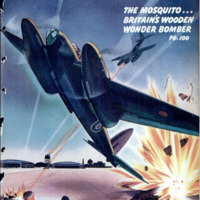 Popular Science Monthly, vol. 143, n. 6, 1943
Popular Science Monthly, vol. 143, n. 6, 1943

